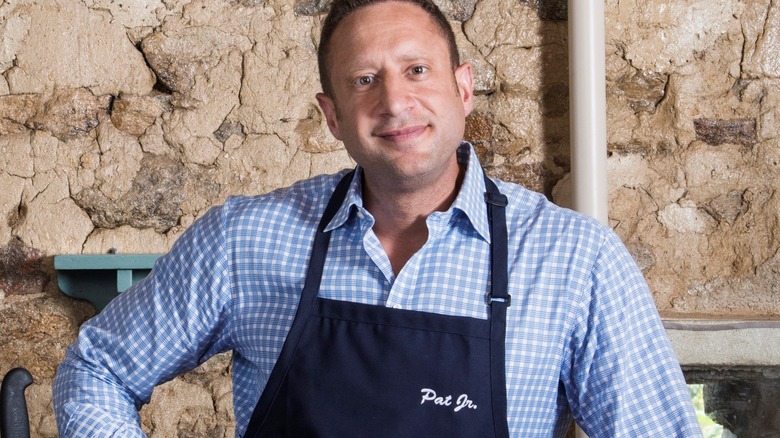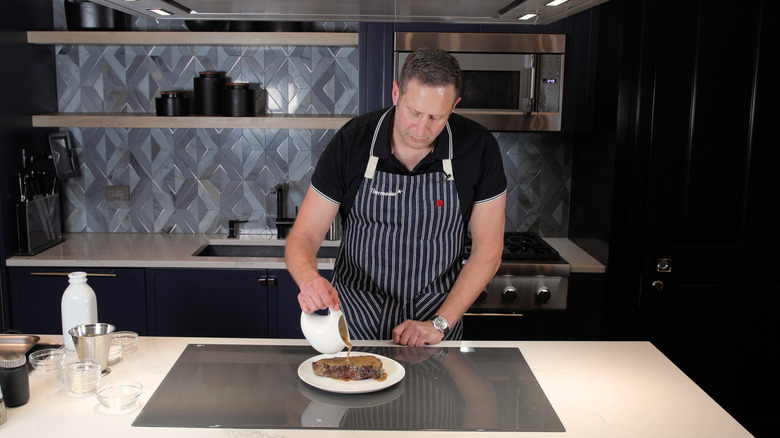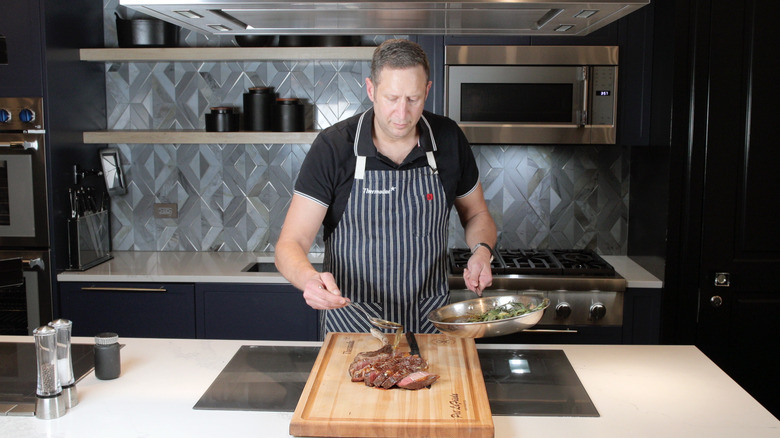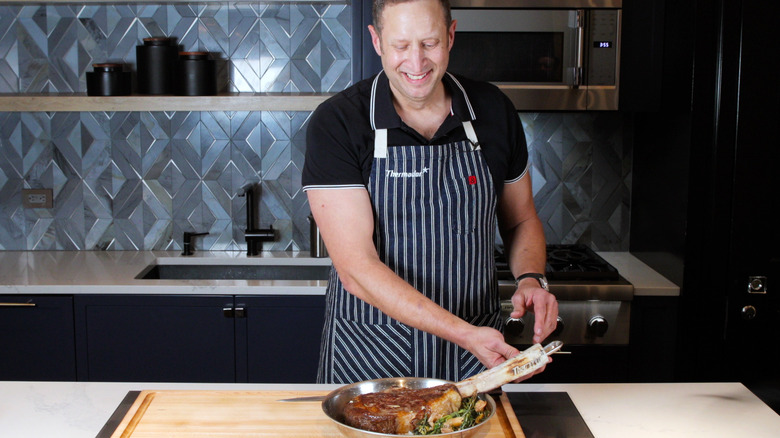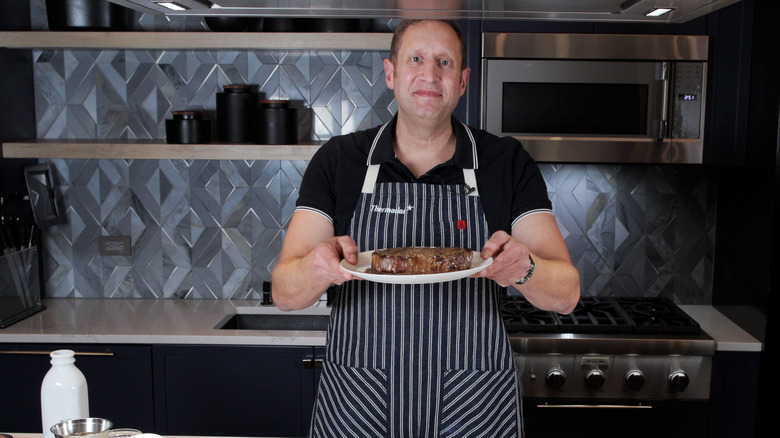Pat LaFrieda On His Top Steak Tips And Why Induction Cooking Is Superior - Exclusive Interview
Even if you don't recognize the Pat LaFrieda Meat Purveyors name immediately, that doesn't mean that you haven't enjoyed some of the brand's products. The New Jersey-based company sources and processes high-quality meats before distributing them to a long list of clients in the restaurant and hotel sectors (including Shake Shack). While the company was founded in 1915 as a much simpler butcher shop in Brooklyn, today, the third Patrick LaFrieda oversees a substantial empire of all things meat, taking the brand's cut-above-the-rest offerings to not just restaurant clientele, but also directly to home cooks' doors via a home delivery program. Pat LaFrieda Meat Purveyors also now has its own restaurants, including Pat LaFrieda's Chop House at Citi Field and a food hall outpost at Time Out Market New York.
All the above considered, then, it's just a given that Pat LaFrieda III knows meat, from buying it to cooking it. LaFrieda recently partnered with Thermador to educate home cooks on induction cooking and Thermador's induction cooktops, and he gave Chowhound all the details on this and more.
The most powerful and precise way of cooking
For those who are unfamiliar, what is induction cooking?
Induction cooking is the most powerful and precise way of cooking, using a magnetic technology that is flameless. For me, that solves a lot of problems, and it's fast and efficient. There's no faster way to get up to the heat that someone like myself is looking for when searing a steak or even boiling water for pasta. There's just nothing faster than induction.
Is that the main benefit people can expect? That fast, high level of heat?
Yes, but [also] how precise it is. When you just have an electric cooktop, that heat is normally dispersed unevenly throughout a ring, whereas this technology heats up the entire surface area of your cooking surface, but it's precise so it's steady. That's really important. You don't have these dips in heat throughout the cooking process — and, for me, I'm always short on time. [Induction cooking's] efficiency and speed are really two of its greatest attributes, for me.
Why is induction cooking specifically a good choice if you're going to cook something like a steak?
You can get the temperature up really hot, really quickly. I like to reverse sear steaks, so I like to cook them on a lower heat for a little bit — but when you want to turn [the heat] up and sear [the steak], you won't overcook it using induction, because you can turn the heat up so dramatically fast that you go from a resting state to a searing state in seconds.
For those home cooks who maybe aren't familiar with the reverse sear technique, explain that for us. What do they need to know and what are your tips?
The reason to sear steak in the first place is for texture and flavor. The flavor really comes out, and [there's the] Maillard reaction, which is the reduction of sugars on the protein. The texture is really crispy on the exterior.
Traditionally, a sear is put on a steak first and, then it's taken off the heat and then put into a lower heat to cook through to the wellness that's desired — but when you do it that way, you lose a bit of the sear, as far as the crispness, and that loses a little bit of the special characteristics of a steak. Once you try reverse searing, you'll understand. It's easy to do and, once you try it and you see the difference, you probably won't ever cook the traditional way again.
Tell us about your relationship with Thermador. Why was that a partnership you were interested in? Why was it a good fit for you and your brand?
When we partner with companies, it has to be an organic fit. I have been using induction for a few years and, when it's truly something that I really believe in, it's easy for me to get behind it. I introduced my team to induction [cooking], and there were definitely some non-believers on my team. I have some veterans in the food industry [on my team], and they were quite shocked about its performance — in a very positive way. So, when you have those kinds of synergies that happen naturally, that's the only way we partner with any company. It has to feel right for us. It has to be something that's true to what we do.
Pat LaFrieda's top steak tips
Regardless of what kind of cooktop someone at home is using, do you have any top tips for making a great steak at home? Or any common mistakes that you see home cooks making that they really need to avoid?
When cooking a steak at home, whether you're reverse searing it or not, you don't have to go from the stovetop into an oven to cook the steak to your wellness. You [can] use one cast iron pan, or I like the non-stick induction pans myself. If you do it all in that one pan, it saves you a lot of time. It saves you from having to heat up an oven. When I see most of my friends cook steaks that way, I ask them "Why the two? Why have the oven on also?" It's just something they saw or learned from a cooking show, and they thought that was the right way. When I show them [how to use] one pan to cook and sear, they really never go back to putting the oven on, especially in the summer. The less you heat up, the better, and it's a waste.
Before home cooks even get to that cooking process, do you have any tips for picking out or buying your steaks? Any particular cuts they need to look for? Anything they should be aware of at the butcher's or the grocery store?
The number one tip I give anyone about buying meat is that America has the best meat sources in the world. The world's greatest and most affluent cities import American beef and American meat, lamb, veal, pork, [and] poultry. The idea that we can get meat fresh, never frozen, seven days a week, usually in almost any town, that's something we take for granted. So ...it doesn't have to be local to within a few miles of your home, [so long as] the source is close enough to be fresh. As long as that package in the retail store has a USDA number on it, an establishment number, that means [it's] traceable back to its origins. So I think country of origin is really important, and meat that's fresh is important.
Now, if you want to freeze it yourself, there's nothing wrong with that, if you buy in bulk ... and you're freezing it for the first time. You wouldn't want to buy something frozen, have to defrost it, and then divvy it up and then freeze it again.
How Pat LaFrieda takes his steak
If you're personally making a steak for yourself at home, what kind of steak are you choosing? And walk me through that process. How does it get to the plate?
My favorite cut of beef is outside skirt steak. I'm very specific when I say outside, because there is an inside skirt that's nowhere near as valuable and nowhere near as flavorful. When it comes to an outside skirt steak, it has the most unique flavor of any cut of beef. It was my grandfather's favorite steak. It was my dad's. It's mine. It's not the most tender piece. It has striations in the muscle that are pretty pronounced. But it's the flavor and the fat; the intramuscular fat is something that just resembles nothing else in cattle.
So, when I'm going to cook a skirt steak, first off, [I'm] making sure that it's the outside skirt. I'm lucky enough that I'm able to find prime beef. I use USDA-graded prime. The skirt steak has a membrane on both sides of the protein, so those need to be peeled off and the corners on each side need to be trimmed. Skirt steak is something that you could use a one-minute marinade on, or some type of coating, however you like to marinate, but you don't need to marinate it for long. The flavors carry through.
Then, there's one trick, if you're cooking inside: the addition of sugar... just a dusting, not even enough for you to taste that the meat is any sweeter. It's another form of searing where instead of the Maillard reaction, you're actually reducing the sugars. You're actually cooking sugars. It gives you that nice brown coating. We use confectionary brown sugar for that, and it's really just a dusting. That, medium rare, is really all I need.
If people have leftover steaks, do you recommend they reheat those the next day? Or are you in the camp of "don't reheat a steak, it's not going to taste the same"?
As long as you know that you're going to have extra steaks — and, this is common, especially when making a beef roast for the holidays, if you know you're not going to eat the entire roast — leave it much rarer than you would like it. Then, you can heat it up the next day and it will not overcook. I utilize that technique with anything. Whenever I know I'm going to have extra product, extra meat, I always [cook] it much rarer than I would [otherwise]. It's a big difference.
Now, in addition to that, when I grew up, finding a nice cold roast beef to slice was common. You can't really find that red roast beef anymore. So ,if you do undercook it with the idea that you're planning to eat it the next day, you don't have to reheat it. You can just slice it thin and you'd have that traditional roast beef that we had as kids.
The secret to Pat LaFrieda Meat Purveyors' success
For people who maybe aren't that into steak, are there any other foods that you would say induction cooking is particularly good for?
Yes. As I mentioned earlier, induction cooking is amazing for simple things like making pasta. You'll not find another way to heat and boil water faster than with induction. We eat a lot of pasta in my family, and it's one of those things that, the speed of the induction really helps that process move along. So I think that's, to me, besides searing steaks, boiling water is the next [best] thing to do with induction.
Your family has been in this business for a really long time. Do you credit anything in particular for the brand's longevity, and how do you think it still remains relevant today?
We are constantly innovating and we, as a family business, reinvest in our business. We reinvest in technology, in machinery, and anything that will help us keep the quality the way it's supposed to be. To do that while you're expanding is difficult... An example is, in my dad's generation, they would start real early in the morning, at 3:30 AM, because restaurants would call late...which they still do. My dad would be there to fulfill those orders and cut whatever meat he needed to, and get his trucks loaded and the drivers to go out on deliveries.
We have to do that now, but [at] about 700 times larger, so we just work throughout the night and split the shifts into four. That kind of dedication is the only thing... I mean, you have to love what you do, live it and really become it to be successful, because about 5% of third-generation companies are successful in America. It's not a lot. It's a very small number. So it really does take those efforts to be successful.
Anything else you wanted to mention?
The only thing with the induction [cooking], which to me has been very easy, is that you have to make sure you have an induction pan or something that a magnet would stick to — that's an easy way to test it. To me, not having that flame, being able to walk away from it for a moment, not having to worry about flame-ups or anything like that — it's a big help.
Learn more about Thermador's induction cooktops at the company's website. You can have premium cuts of meat shipped to your house directly from Pat LaFrieda Meat Purveyors.
This interview has been edited for clarity.
